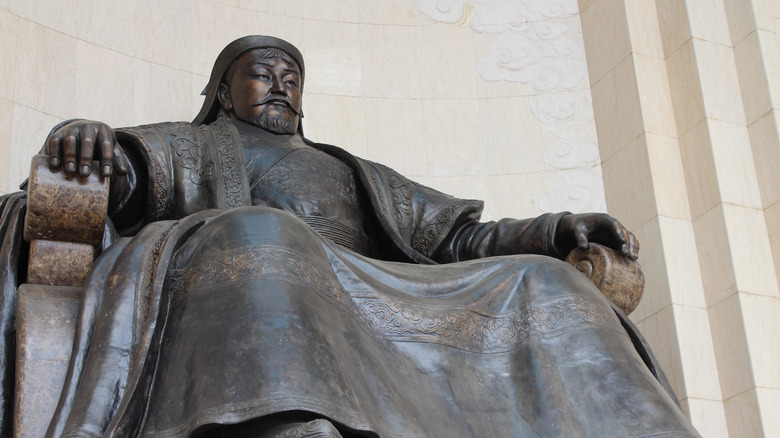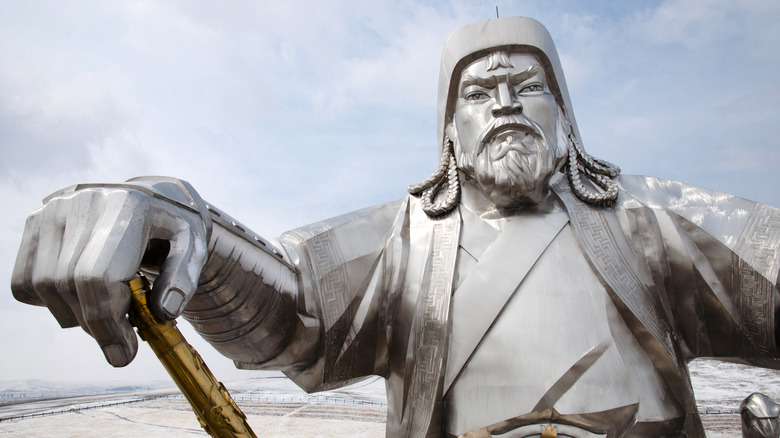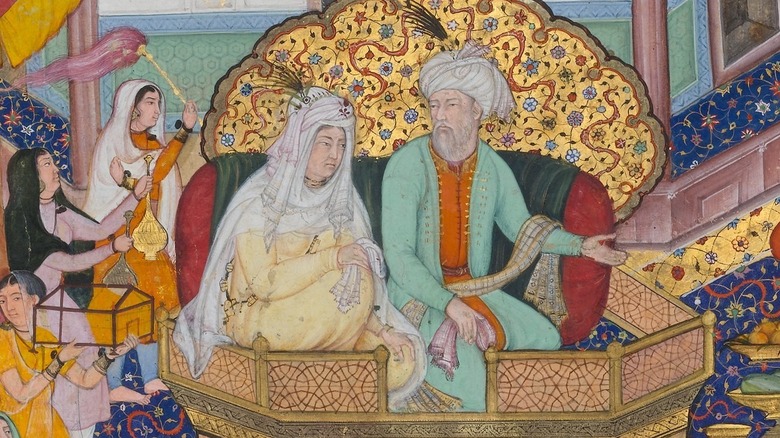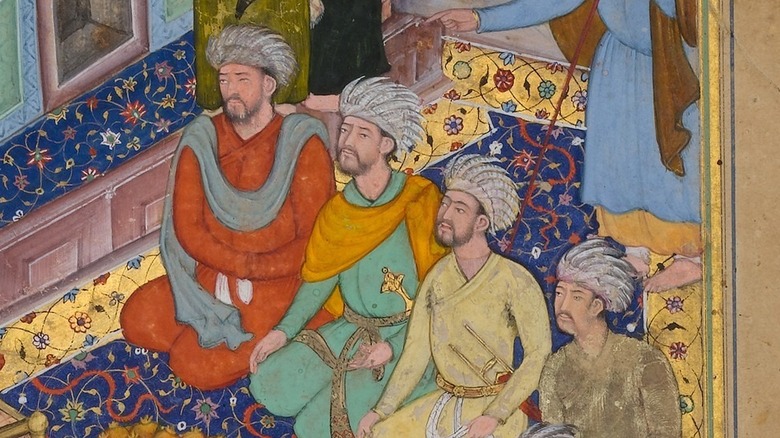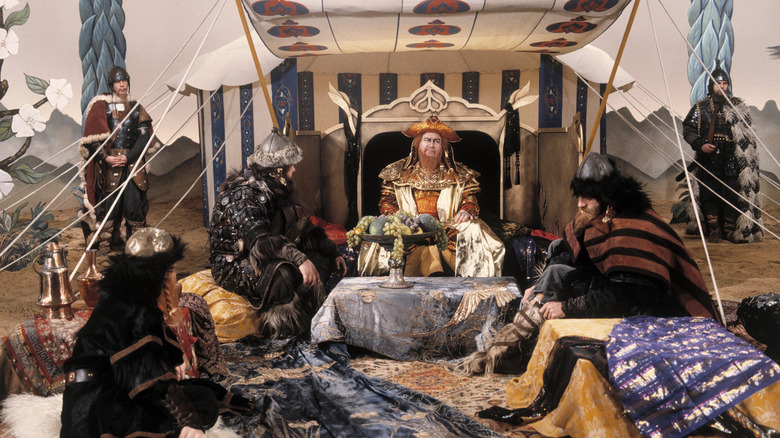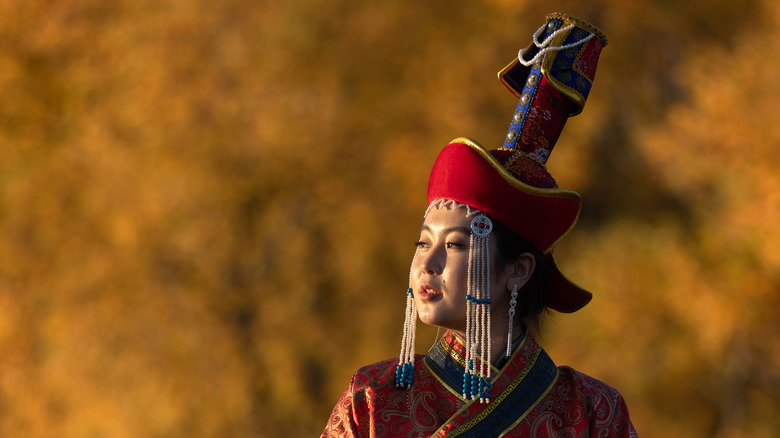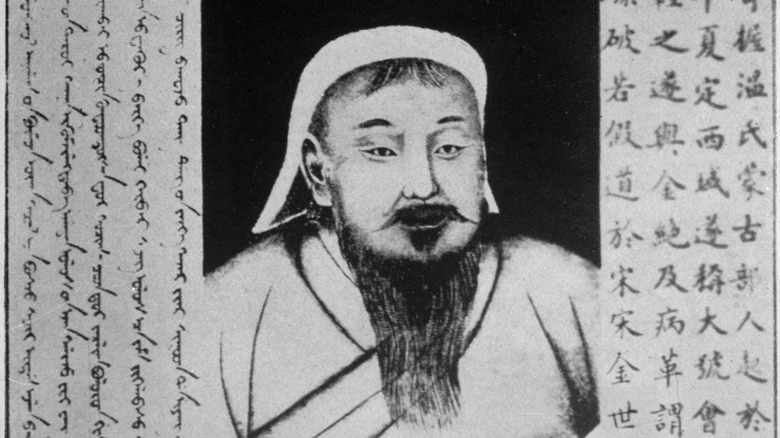How Many Children Did Genghis Khan Really Have?
To the victor goes the spoils, as they say, and Genghis Khan was nothing if not victorious. On his bloody march across Asia, he claimed a lot of — well – spoils. The "Great Khan" and ruler of the medieval Mongolian Empire lived from approximately 1162-1227. He was born in the war-ravaged region along the modern border of Siberia and Mongolia. Over the course of his violent life, he united several warring Mongol tribes into an organized army that conquered wide swathes of Asia. He accomplished this task where other Mongolian warlords had failed by claiming several different wives and concubines from the competing tribes and petty kingdoms in the region.
Genghis Khan came by this strategy honestly. His father actually kidnapped his mother from a warring tribe and sired Genghis to consolidate his own power in the region. Genghis, known early in his life as Temujin, took his father's game to the next level, claiming at least six Mongolian wives and over 500 concubines. Despite these prodigious numbers, evidence suggests that the Great Khan made time for all of them and that their unions were ... productive. So how many children sprang forth from this fecund general's loins? And just who were some of them?
Genghis Khan spread his seed
An historical genetics study concluded in 2003 showed that as many as 16 million living men were likely direct-line descendants of Genghis Khan. The researchers found to their ample surprise that about 1 in 200 males alive at the time of the study had genetic indicators on their Y-chromosomes suggesting they were all descended from a single male "super father" living approximately 1,000 years ago. In other words, Genghis may have been on horseback, but that dude got around. This result suggests that the Great Khan may have produced hundreds of sons by his concubines and younger wives that were never formally recognized and therefore went unrecorded by history. So how many biological sons did Khan have? Probably a ton, even though we can't exactly know.
But there's another answer to this question. According to Mongolian law at the time, rulers had to derive from a Golden Lineage. This means Genghis Khan likely only recognized his four sons by his first wife as actual sons. These four Mongolian heirs — Jochi, Chagatai, Ogedei, and Tolu — inherited the Khan name, even if hundreds of others may have inherited the Khan DNA.
The forgotten daughters of the queen
Even though Genghis Khan's male heirs from his primary wife, Queen Börte, receive far more attention, the great conqueror also bestowed a significant amount of power upon his daughters born from the queen as well. Not only did Börte rule over her own territory, but the Khan also realized the superior leadership abilities of their daughters and gave them strategic locations throughout the vast empire to govern over.
In his book, "The Secret History of the Mongol Queens," Jack Weatherford listed six of Genghis' most prominent female heirs as Khojin, Alaqai, Al-Altun, Checheyigen, Tumelun, and Tolai, but added it is likely that not all of them were the children of his senior consort. However, Börte certainly had no more than six daughters, which including her four sons, would mean she had ten children at most. Although the Khan had numerous other wives, none of them had anywhere near as many children with the Mongol ruler.
Qulan and her special son, Kölgen
Börte may have been the senior queen, but that did not mean Genghis Khan had no affection or respect for his lesser royal wives and their children. It was simply the case that their lower political status prevented these other sons and daughters from inheriting anywhere near as much power from their father. One notable exception to this rule was Kölgen, the son of the former Merkit princess Qulan.
In the winter of 1203 – 1204, the Khan accepted the daughter of the rival Merkit ruler as his wife. It is unknown how Qulan truly felt about Genghis after he killed her father when the two went to war, but according to "The Secret History of the Mongols," a rare primary account of the conqueror and his family, the Khan loved his new wife from the beginning. Over time, it is possible the minor queen grew to love her husband as well as she proved to be highly effective at managing imperial camps. Qulan was so trusted by Genghis that she even oversaw the baggage train for the Western Campaign nearly 20 years later.
Though the main way that the Mongol ruler showed how much he favored Qulan was the way their only son was treated. Like the heirs of Börte, Kölgen led warriors on campaigns and was given just as many troops to command as his half-brothers. On the other hand, his inferior position forbade Kölgen from ever ruling any part of the empire.
The royal sisters, Yesugen and Yesui
Along with Qulan, Genghis Khan had several other wives from conquered families like the Tatar sisters, Yisügen and her older sibling, Yisüi. After their father was defeated by the Mongol forces in 1202, the two women agreed to become consorts of the Khan and then used their prominent positions to protect what was left of their vanquished people, says Anne F. Broadbridge in her book, "Women and the Making of the Mongol Empire." And Genghis must have cared for the sisters because he often granted their wishes, such as taking in their younger brothers, regardless of the danger of them seeking revenge later.
The Tatar sisters were two of Genghis' most important wives, but the unions only produced one child, Cha'ur, the son of Yesugen. Unlike Kölgen, Cha'ur was always very solidly a secondary son and unfortunately did not live long enough to commit some great act of valor and possibly improve his status.
Other distinguished wives of the great conqueror
Genghis Khan had many other consorts that may not have been as politically significant, but were still important to the ruler, such as the Kereit princess Ibaqa and especially the concubine Moga. Conversely, the Khan also made several women into wives and concubines for the only purpose of reinforcing his dominion over their people, including Chaqa, the Tangqut princess, Princess Qiguo, and the queen of the Naimans, Gürbesü (via "The Secret History of the Mongols").
Yet, "Women and the Making of the Mongol Empire" points out that none of these queens and princesses had children with Genghis who made it into the historical records, no matter how close they were to him. There are only two other sons named in the accounts — Orchan, the son of a Tatar concubine, and Jürchedei, the son of a Naiman concubine. The names of some of the Khan's daughters are known, like Alajai, Chalun, Töre, and Ikires, however, there is no way to tell who their mothers were.
Genghis Khan's hundreds of concubines and their offspring
If the Persian chronicler of the 14th century, Rashid ad-Din (via "Before the Dawn"), is correct about the staggering number of wives and concubines Genghis Khan had, then he must have had an insane amount of children, and that would explain why he has so many living descendants. But even though it is impossible to know the exact number of his offspring, a theoretical range can be determined.
Given what is known about the Khan's recorded consorts and children, it is very likely that his progeny did not exceed one or two per concubine, per "Women and the Making of the Mongol Empire." Plus, some of these women did not bear any of his children at all. Therefore, it would not be a stretch to think that there may have been as little as hundreds of mini-Khans running around the medieval world. This also means that Genghis probably did not have much more than 1,000 children at max (although the guy really did get around).
